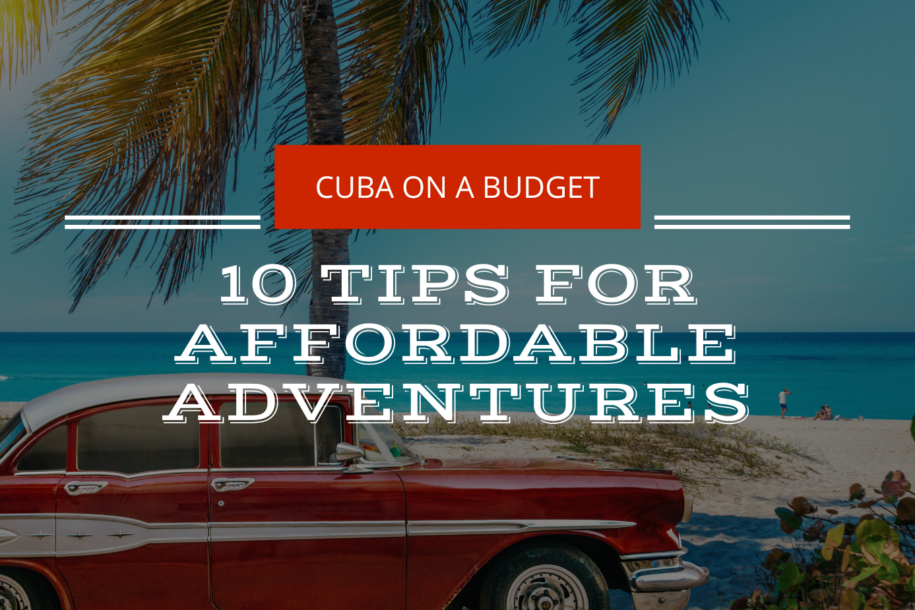Planning to visit Cuba on a budget?
Immersing yourself in the vibrant and culturally rich island of Cuba doesn’t have to come with a high price tag. While it’s easy to envision Caribbean travels as expensive, Cuba offers an array of opportunities to experience its majestic landscapes of Cuba, colonial architecture, and spirited culture affordably.
This guide will share ten essential tips to help you explore Cuba without straining your wallet, ensuring a rich, memorable journey through this unique island nation.
Table of Contents
Is it possible to visit Cuba on a budget?

Absolutely!
Visiting Cuba on a budget is not only possible but also quite common among travelers. While it’s true that Cuba has its share of luxury resorts and high-end experiences, there are plenty of ways to explore the island without breaking the bank. By embracing local accommodations like casas particulares, dining at paladares, using public transportation, and engaging with locals, you can significantly reduce your expenses while still experiencing the rich culture, history, and natural beauty that Cuba has to offer.
Additionally, traveling during the off-peak season, packing smartly, and seeking out free or low-cost attractions can further stretch your budget. With careful planning and a willingness to immerse yourself in the local culture, visiting Cuba on a budget can be a rewarding and memorable experience.
Let’s dive into the details.
1. Stay in Casas Particulares
To truly dive into the Cuban experience while keeping costs low, opt for ‘casas particulares’ over traditional hotels. These private homestays are akin to bed and breakfasts, where you rent a room in a family’s home. They provide not only a cozy place to stay but also a golden opportunity to interact with locals and enjoy homemade Cuban meals—often at prices significantly lower than hotels. This arrangement also supports local families directly, making it a socially responsible choice.
2. Dine in Paladares
For authentic Cuban cuisine, skip the tourist traps and dine at ‘paladares’, small, family-run restaurants often located within someone’s home. Here, you’ll enjoy hearty, authentic meals at a fraction of the cost of high-end restaurants, plus the atmosphere is typically warm and welcoming. Favorites to try include ropa vieja (shredded beef), yuca con mojo (yuca with garlic sauce), and plantains, all staples of the Cuban diet.
3. Travel During Off-Peak Times
Timing your visit can have a big impact on costs. Traveling during the off-peak seasons (May to November) can result in lower prices for accommodations and more personalized service. Although you might contend with the rainy season, the showers are usually short and can offer a refreshing break from the heat.
4. Utilize Public Transportation
Explore like a local using Cuba’s extensive public transportation network. While the buses are crowded and can be infrequent, they offer an authentic experience and are incredibly cheap. For travel between cities, consider the ‘camiones’—converted trucks used as buses—or the national bus service, Viazul, which is reliable and reasonably priced.
5. Explore on Foot or Bicycle
Many of Cuba’s cities are perfect for walking or cycling. Rent a bike for a few dollars a day to explore places like Havana, Trinidad, and Viñales. Not only do you save on transport costs, but biking also allows you to see the lush countryside and stunning coastlines at your own pace, stopping wherever and whenever you like.
6. Pack Smartly
Bring essentials with you to avoid paying premium prices in tourist centers. Items like sunscreen, insect repellent, toiletries, medications, and snacks can be much more expensive in Cuba. Additionally, carrying a reusable water bottle can save money and help reduce plastic waste, as safe drinking water is available in many hotels and eateries.
7. Engage with Locals
One of the richest experiences in Cuba is interacting with its people. Cubans are generally very friendly and engaging. Attend local events, or even a local baseball game, to strike up conversations and gain insights into everyday Cuban life and culture. Learning a few phrases in Spanish before you go can also enrich your interactions.
8. Enjoy Free or Low-cost Attractions
Cuba offers numerous free or inexpensive attractions. In Havana, you can visit the iconic Malecón or explore the historic neighborhood of Old Havana (Habana Vieja) to enjoy street music, vibrant art, and historical sites at no cost. Many cities also have local museums with low admission fees that are worth visiting.
9. Practice Bargaining
In markets and street stalls, bargaining is expected and part of the fun of shopping in Cuba. Whether you’re buying souvenirs, artwork, or local produce, don’t hesitate to negotiate. It’s a great way to interact with vendors and save money simultaneously.
10. Hire a Local Guide
While it might seem counterintuitive when trying to save money, hiring a local guide for at least part of your trip can actually be cost-effective. A good guide can provide context to the sites you visit, helping you avoid tourist traps and introducing you to lesser-known spots you might otherwise miss. They can also help in negotiating deals and suggest the best ways to enjoy Cuba on a budget.
Frequently asked questions
What is the best way to save on accommodations in Cuba?
The best way to save on accommodations in Cuba is by staying in casas particulares. These are private homes licensed by the government to offer lodging to tourists. Staying in a casa particular not only provides a unique opportunity to experience authentic Cuban hospitality, but it also tends to be much cheaper than hotels. Prices vary, but you can generally find rooms ranging from $20 to $40 per night, often including breakfast. Additionally, staying with locals provides insights into Cuban life and culture that you might miss in more conventional accommodations.
How can I keep food costs low while traveling in Cuba?
Eating like a local is the key to keeping food costs low in Cuba. Avoid dining in hotels or tourist-heavy areas where prices are marked up. Instead, opt for paladares (small family-run restaurants) and street food vendors. Meals at paladares are usually made from fresh, local ingredients and are priced much lower than those at restaurants geared towards tourists. For even cheaper options, look for local peso food stands, which sell inexpensive Cuban staples like sandwiches, pizzas, and snacks. Always carry some snacks like biscuits or fruit for long travel days, as these can be harder to find in remote areas.
Is it possible to travel around Cuba using public transportation?
Yes, it’s definitely possible to travel around Cuba using public transportation, which can help you keep your travel costs low. For city travel, local buses are very affordable, though routes can be confusing and buses crowded. For longer distances, the state-run Viazul buses are a reliable and affordable option designed for tourists, connecting major cities and tourist destinations. Tickets are reasonably priced, but it’s advisable to book them in advance online or at bus terminals due to high demand. Alternatively, shared taxis, known as colectivos, are a common sight in Cuba. These are usually classic cars that run on set routes and are shared by multiple passengers, making them a budget-friendly and quintessentially Cuban way to travel.
Conclusion
Visiting Cuba doesn’t have to be expensive.
With these ten tips, you’re equipped to explore this fascinating country without splurging. From staying in casas particulares and eating at local paladares to using public transport and engaging with the locals, each strategy not only saves you money but also deepens your travel experience, letting you see the real Cuba beyond the usual tourist experiences.
Prepare to be charmed by the beauty, culture, and spirit of this unique Caribbean nation.
